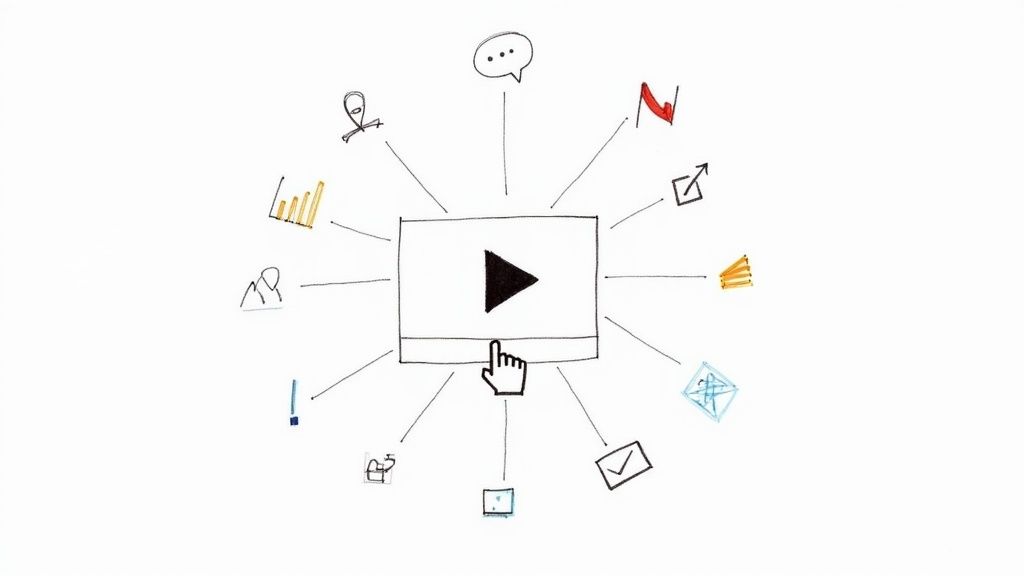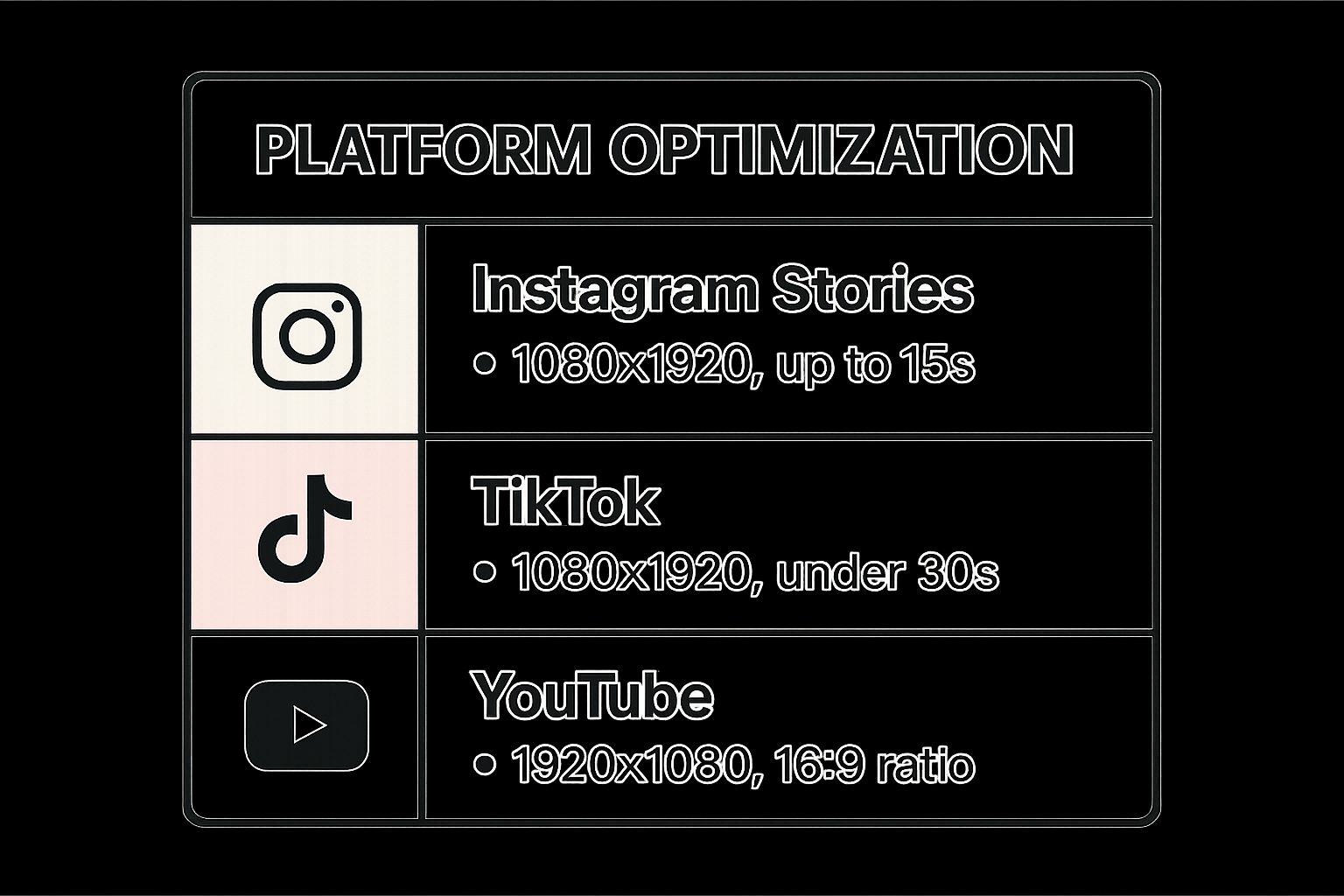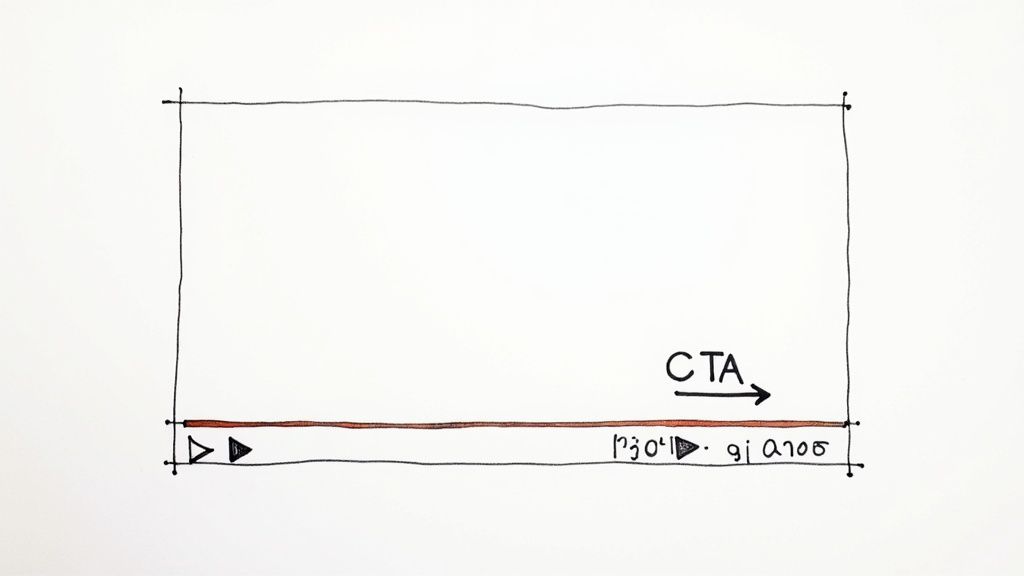
8 Interactive Video Marketing Tips for 2025
In a world saturated with content, standard videos are no longer enough to capture attention and drive action. The future of digital engagement lies in making your audience active participants, not passive viewers. This article moves beyond generic advice to provide eight advanced video marketing tips focused on creating interactive, data-driven experiences that captivate your audience and deliver measurable results.
You'll get actionable strategies on everything from hooking viewers in the first three seconds to leveraging powerful analytics. We will explore how to implement these techniques to transform your video content into a powerful engine for engagement, lead generation, and growth. Each tip is designed to be directly applicable, whether you're creating social media clips, detailed tutorials, or sales demos.
To truly succeed in video marketing, especially with long-form content, consider investing in professional video podcast production to ensure high-quality visuals and audio that hold viewer attention. This guide will give you the strategic foundation to make that investment count, turning passive viewers into loyal customers. Let's dive into the strategies that will redefine your approach to video.
1. Hook Viewers in the First 3 Seconds
In the fast-paced digital landscape, viewer attention is a scarce commodity. The first three seconds of your video are the most critical real estate you have. If you fail to capture interest immediately, your audience will simply scroll past. This is why leading with a powerful hook is one of the most essential video marketing tips for stopping the scroll and encouraging viewers to commit to your message.

A hook is an opening that uses a compelling visual, a provocative question, a bold statement, or an immediate value proposition to create instant intrigue. It disrupts the passive scrolling behavior common on social media feeds and gives viewers a reason to stay. This technique tells the audience why they should care before they have a chance to look away.
How to Implement a Powerful Hook
Creating an effective hook doesn't require a massive budget, just a strategic approach. Consider these actionable methods:
- Start with the End Result: Show the finished product or the "after" state of a transformation. BuzzFeed's Tasty videos master this by opening with a shot of the delicious final dish.
- Ask a Compelling Question: Pose a question that your target audience wants answered. For example, a financial advisor might start with, "Are you making this common retirement mistake?"
- Use a Pattern Interrupt: Grab attention with an unexpected sound, a sudden camera movement, or a surprising visual. This breaks the viewer's mental pattern and makes them focus.
- Lead with a Shocking Statistic: A surprising fact or data point can immediately establish authority and create curiosity.
- Preview the Peak Moment: Show a quick, exciting clip from later in the video, much like a movie trailer does.
Dollar Shave Club’s famous launch video is a prime example of a perfect hook. It opens with the founder confidently stating, "Hi, I'm Mike, founder of DollarShaveClub.com. What's so great about our blades? Well... they're f***ing great." This bold, humorous, and direct opening instantly defined their brand and captivated millions, proving that the first few seconds are your most valuable asset.
2. Optimize Videos for Each Platform
Posting the same video file across all your social media channels is a missed opportunity. Platform optimization is the practice of tailoring your video content to fit the unique technical requirements, audience behaviors, and algorithmic preferences of each platform. This is one of the most impactful video marketing tips because it ensures your content feels native to the environment, boosting its reach and engagement significantly.
Different platforms favor different aspect ratios, video lengths, and even caption styles. A one-size-fits-all approach signals to both the algorithm and the audience that the content wasn't made for them, leading to lower performance. By customizing your video for each channel, you respect the user experience and maximize your chances of success.
How to Implement Platform Optimization
Effectively optimizing your videos doesn't mean creating entirely new campaigns for each channel. It's about strategically editing a master video file to create bespoke versions. Here's how to approach it:
- Adapt Aspect Ratios: Use vertical (9:16) for TikTok and Instagram Stories/Reels, square (1:1) for Facebook and Instagram feed posts, and horizontal (16:9) for YouTube and LinkedIn.
- Adjust Video Length: Keep videos for TikTok and Reels short and punchy, ideally under 30 seconds. YouTube can support longer-form content, while feed posts on Facebook perform best when kept concise.
- Add Native Captions: Since 85% of Facebook videos are watched without sound, hard-coding or uploading SRT captions is crucial. Customize the style to match the platform's aesthetic.
- Use Platform-Specific Trends: Incorporate trending audio on TikTok or use platform-specific humor and hashtags that resonate with the audience on Twitter versus the more professional tone of LinkedIn.
- Schedule for Peak Times: Analyze your audience data on each platform to post when they are most active. A tool like Buffer or Hootsuite can help automate this process.
To help you get started, here is a quick reference guide to the technical specifications for some of the most popular platforms.

This visual guide highlights the fundamental differences in orientation and length, showing why a single video file cannot perform optimally everywhere. For instance, Netflix expertly adapts its movie trailers from a cinematic 16:9 format for YouTube into compelling vertical 9:16 cuts for Instagram Stories, ensuring each version feels perfectly suited to its environment and captures viewer attention effectively.
3. Tell Stories, Don't Just Sell
Consumers are inundated with sales pitches, making it easy to tune out purely promotional content. The most effective way to cut through the noise is to focus on narrative rather than a hard sell. Story-driven video marketing builds an emotional connection by creating a memorable experience, a crucial strategy among top video marketing tips for fostering long-term loyalty and brand affinity.
This approach uses a classic narrative structure with characters, conflict, and resolution to engage viewers on a deeper level. By focusing on a universal human experience or a transformative journey, your brand becomes the backdrop to a compelling story, not just the subject of an advertisement. This makes your message more relatable and your brand more memorable.
How to Implement Storytelling in Your Videos
Integrating a narrative doesn't mean you need a Hollywood budget; it requires a shift in perspective from selling a product to sharing an experience. Here are a few ways to get started:
- Start with a Relatable Character: Create a protagonist your target audience can see themselves in. Their struggles and triumphs should mirror your customer’s own journey.
- Build a Clear Narrative Arc: Introduce a conflict or challenge, show the character's journey to overcome it (subtly aided by your brand), and conclude with a satisfying emotional resolution.
- Use the "Hero's Journey": This classic framework positions your customer as the hero and your brand as the guide or tool that helps them succeed on their quest.
- Keep Branding Subtle: Let the story take center stage. The goal is for the audience to connect with the narrative first; the brand association will follow naturally and feel more authentic.
- Leverage Customer Testimonials: Transform a positive customer review into a mini-story. Show their "before" state, the challenge they faced, and how they found success.
Campaigns like Dove's "Real Beauty Sketches" and Always' "Like a Girl" are masterful examples. They don't focus on product features; they tackle profound emotional and social themes, making the brand synonymous with a powerful message. This storytelling approach is what separates a forgettable ad from a cultural moment. To dive deeper into crafting compelling narratives, you can learn more about storytelling in video on mindstamp.com.
4. Include Clear Call-to-Actions (CTAs)
A great video without a clear next step is a missed opportunity. Your content might entertain or inform, but to drive business results, you must guide the viewer on what to do next. Including a strategic call-to-action (CTA) is one of the most fundamental video marketing tips for converting passive viewers into active leads, subscribers, or customers. It bridges the gap between engagement and conversion.

A video CTA is a prompt that encourages your audience to take a specific action. This can be a clickable button, a verbal instruction, or an on-screen graphic. The key is to make the desired action obvious, compelling, and easy to complete, transforming your video from a simple piece of content into a powerful marketing tool.
How to Implement Effective CTAs
Integrating CTAs effectively requires a thoughtful approach to timing, design, and language. Here are some actionable methods to get started:
- Use Strong Action Verbs: Start your CTA with direct commands like "Download," "Subscribe," "Shop Now," or "Learn More." This clarity eliminates confusion and tells the viewer exactly what to do.
- Place CTAs at Natural Transition Points: The end of a video (post-roll) is a classic placement, but mid-roll CTAs can be powerful when a specific product or concept is mentioned. For instance, a fitness influencer might place a CTA for their program right after demonstrating a key exercise.
- Make Them Visually Distinct: Your CTA button or text should stand out from the video background. Use contrasting colors, bold fonts, and simple animations to draw the viewer's eye without being overly distracting.
- Combine Verbal and Visual Cues: Reinforce your on-screen button by having the speaker verbally state the call-to-action. Saying, "Click the link in the description to get your free guide," while the link is shown on screen is highly effective. Learn more about how to add call-to-action buttons to your videos.
- Create Urgency: Motivate immediate action by incorporating scarcity or time-sensitivity. Phrases like "Limited-Time Offer" or "Get 20% Off This Week Only" encourage viewers to act now rather than later.
HubSpot excels at this by ending its educational videos with offers for relevant free tools or downloadable guides, perfectly aligning the CTA with the content the viewer just consumed. Similarly, YouTube's end screen feature is a built-in tool that allows creators to add CTAs to subscribe, watch another video, or visit an external website, making it a seamless part of the viewing experience.
5. Keep Videos Concise and Focused
In an era of information overload, respecting your viewer's time is paramount. Optimizing video length isn't about making everything as short as possible; it's about delivering maximum value in the minimum amount of time. This strategy requires stripping away fluff to ensure every second serves a purpose, keeping your audience engaged from start to finish. A concise and focused video is one that viewers will watch completely, which is one of the most effective video marketing tips for boosting completion rates and message retention.
This approach, popularized by platforms like TikTok and Instagram Reels, forces creators to distill their message to its most potent form. Whether it's a 90-second explainer video breaking down a complex service or a 15-second social ad, the goal is the same: deliver a clear, memorable takeaway without unnecessary filler. This ensures your key message lands effectively before the viewer's attention inevitably wanders.
How to Implement Concise Video Content
Creating impactful short-form content is a discipline that blends strategic planning with ruthless editing. Here’s how to master it:
- Define One Core Takeaway: Before you even think about filming, decide on the single most important message you want your audience to remember. Build the entire video around this one point.
- Script with Bullet Points: Avoid dense paragraphs. Scripting with bullet points or a tight outline helps you stay on track and communicate ideas clearly and quickly.
- Edit Aggressively: Cut every pause, tangent, and redundant phrase. Use techniques like jump cuts to maintain a high-energy pace and remove any dead air that might cause viewers to drop off.
- Break Down Complex Topics: If a subject is too complex for a single short video, don't try to cram it in. Instead, create a video series where each installment tackles one specific sub-topic.
- Test and Analyze: The ideal video length can vary by platform and audience. Test different durations, such as 15, 30, and 60 seconds, and analyze your metrics to see what your audience responds to best.
A perfect example is the rise of single-tip videos on Instagram Reels. A creator might show a quick 30-second hack for cleaning sneakers or a single productivity tip. These videos are incredibly effective because they are hyper-focused, provide immediate value, and are easily digestible, making them highly shareable and memorable.
6. Leverage User-Generated Content (UGC)
One of the most powerful forms of marketing doesn't come from your brand at all; it comes directly from your audience. Leveraging user-generated content (UGC) involves featuring videos created by your customers and community. This approach builds immense trust and authenticity, as content from real people often feels more genuine and relatable than polished corporate productions. It’s one of the most effective video marketing tips for fostering a loyal community around your brand.
UGC acts as powerful social proof, showing potential customers that real people love and use your products. Brands like GoPro have built their entire marketing strategy around showcasing breathtaking adventure videos shot by their users. This not only provides a constant stream of high-impact content but also strengthens the bond between the brand and its most passionate advocates, turning customers into a volunteer marketing force.
How to Implement a UGC Strategy
Encouraging your audience to create and share content requires a clear and rewarding system. Here’s how to effectively integrate UGC into your video marketing:
- Create Branded Hashtag Campaigns: Launch campaigns with a unique, memorable hashtag. Starbucks' annual #RedCupContest is a perfect example, generating thousands of festive, on-brand videos and photos each year.
- Offer Incentives and Recognition: Motivate participation by offering prizes, discounts, or the chance to be featured on your official channels. The recognition alone is often a powerful motivator.
- Provide Clear Guidelines: Tell your community exactly what you're looking for. Specify video orientation (vertical for stories, horizontal for YouTube), themes, or key products to feature.
- Always Ask for Permission and Give Credit: Before reposting any content, secure permission from the original creator and always credit them prominently in your post. This builds goodwill and encourages more submissions.
- Showcase UGC Across All Channels: Feature the best UGC on your website, social media feeds, email newsletters, and even in paid ads to maximize its impact and reach.
For a deeper dive into practical applications, especially when looking to secure collaborations and monetize user-generated content, consider exploring resources dedicated to specific niches. For instance, this a guide to landing paid UGC deals with brands like Airbnb offers actionable insights for creators. This approach transforms authentic user passion into a scalable and cost-effective content engine that drives both engagement and conversions.
7. Use Data Analytics to Measure and Improve Performance
Creating compelling video content is only half the battle; understanding its impact is what drives long-term success. Video analytics is the process of systematically tracking, measuring, and interpreting performance data to optimize your strategy and maximize ROI. This data-driven approach moves you from guessing what works to knowing what works, transforming your video marketing from an art into a science.
By diving into the numbers, you uncover deep insights into audience behavior, content effectiveness, and areas for improvement. Platforms like YouTube Analytics, Wistia, and even social media insights provide a wealth of information. To truly understand the impact of your video marketing efforts, it's crucial to know how to measure content performance and prove your ROI. This knowledge allows you to make informed decisions that refine your content and justify your budget.
How to Implement a Data-Driven Video Strategy
Leveraging analytics is about focusing on the right metrics and turning insights into action. Here’s how to put this powerful video marketing tip into practice:
- Focus on Goal-Oriented Metrics: Don't get lost in vanity metrics like raw view counts. If your goal is brand awareness, track reach and watch time. If it's lead generation, monitor click-through rates and conversion events.
- Analyze Audience Retention: Pinpoint exactly where viewers lose interest and drop off. These moments are invaluable opportunities to learn. Is your intro too slow? Is a particular segment confusing? Use this feedback to improve future videos.
- Track Traffic and Conversions: Use UTM parameters in your video descriptions and calls-to-action to track how much website traffic your videos are generating. Set up goal tracking in Google Analytics to see which videos lead to sign-ups, downloads, or sales.
- Segment and Compare Performance: Analyze how different video formats (e.g., tutorials vs. testimonials) or platforms (YouTube vs. TikTok) perform. This helps you allocate resources to the channels and content types that deliver the best results.
Tools like Wistia provide detailed heatmaps that show which parts of a video are being rewatched, skipped, or paused, offering a granular view of viewer engagement. For interactive content, you can learn more about viewing your video data and reports on Mindstamp to measure clicks, poll responses, and lead form submissions directly within the player. This level of detail empowers you to continuously refine your approach, ensuring every video you produce is more effective than the last.
8. Invest in Good Audio Quality
While stunning visuals are important, viewers are surprisingly more likely to forgive mediocre video quality than they are to tolerate poor audio. Bad sound, full of hiss, echo, or background noise, is distracting and immediately signals a lack of professionalism. Investing in good audio quality is one of the most impactful video marketing tips because it directly affects viewer retention and the perceived credibility of your brand.
Clear, crisp audio ensures your message is heard without friction, keeping your audience engaged and focused on the content. From corporate testimonials to product demos, professional-grade sound makes your video feel polished and authoritative. This is a crucial element that separates amateur content from professional marketing collateral, enhancing trust and comprehension.
How to Achieve Professional Audio Quality
You don't need a Hollywood-level sound studio; you just need to prioritize audio in your production workflow. Here are practical ways to ensure your sound is crystal clear:
- Use an External Microphone: Never rely on the built-in microphone on your camera or smartphone. A dedicated lavalier (lapel), shotgun, or USB microphone will capture dramatically better sound.
- Control Your Environment: Record in a quiet space with soft furnishings like carpets, curtains, or couches to absorb echo. Turn off fans, air conditioners, and any other sources of background noise.
- Monitor Your Audio: Always wear headphones while recording. This allows you to hear exactly what the microphone is picking up, so you can identify and fix issues like wind noise, muffled speech, or clipping in real time.
- Use Pop Filters and Windscreens: A pop filter placed in front of a microphone minimizes the harsh "p" and "b" sounds, while a windscreen is essential for reducing wind noise when recording outdoors.
- Edit in Post-Production: Use software to balance audio levels, remove unwanted background noise, and add background music. This final polish is what gives your video a truly professional feel.
Tech reviewer Marques Brownlee (MKBHD) has built an empire on the back of his high-quality videos, where pristine audio is non-negotiable. His clear, consistent narration ensures that complex technical details are easy to understand, making his content authoritative and highly engaging. This commitment to audio quality has been a cornerstone of his success, proving that what your audience hears is just as important as what they see.
8 Key Video Marketing Tips Comparison
Elevate Your Marketing with Interactive Video
The journey through modern video marketing is both an art and a science. We've explored the essential pillars of a successful strategy, from crafting an irresistible hook in the first three seconds to the non-negotiable need for high-quality audio. These foundational video marketing tips are your launchpad, but to truly soar in a crowded digital landscape, you must move beyond passive broadcasting and embrace active engagement.
The core principles discussed, such as platform-specific optimization, compelling storytelling, and data-driven iteration, provide the structure for your content. Yet, the real breakthrough happens when you transform your videos from a one-way monologue into a two-way conversation. This is where the power of interactivity comes into play. By embedding elements like clickable buttons, personalized viewing paths, and lead capture forms directly into your content, you bridge the gap between viewer and participant.
Turning Insights into Actionable Strategy
Mastering these video marketing tips is not just about creating better videos; it's about building a more effective, responsive, and profitable marketing engine. Let's distill the key takeaways into a clear action plan:
- Prioritize the Viewer Experience: Every tip, from storytelling to concise editing, centers on respecting your audience's time and attention. Your primary goal is to deliver value, whether through education, entertainment, or a solution to their problem.
- Embrace a Data-First Mindset: Don't guess what works. Use analytics to understand viewer behavior, identify drop-off points, and measure the success of your CTAs. This feedback loop is crucial for continuous improvement and maximizing your return on investment.
- Integrate, Don't Isolate: Your video strategy should not exist in a vacuum. Connect it to your broader marketing goals by leveraging User-Generated Content to build community, telling stories that reinforce your brand identity, and using clear CTAs to guide viewers to the next step in their customer journey.
The ultimate value of implementing these strategies lies in their cumulative impact. A strong hook combined with a clear story and a compelling CTA doesn't just get a view; it creates a memorable brand experience. When you layer interactive elements on top of this solid foundation, you empower viewers to choose their own adventure, giving you unprecedented insight into their interests and needs. This shift from passive consumption to active participation is the single most powerful way to elevate your video marketing, drive meaningful engagement, and achieve tangible business results.
Ready to transform these video marketing tips into an interactive reality? With Mindstamp, you can easily add clickable buttons, questions, personalization, and more to any video, turning passive viewers into engaged customers. Start your free trial today and discover how simple it is to build a video strategy that not only captures attention but also drives action.
Get Started Now
Mindstamp is easy to use, incredibly capable, and supported by an amazing team. Join us!



Try Mindstamp Free










